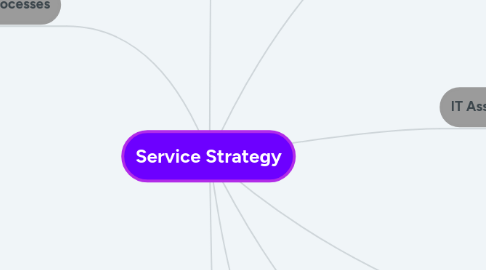
1. Processes
1.1. Planning for risk management
1.1.1. Level of risk that the organisation considers tolerable
1.1.2. Who will be responsible for what risk?
1.2. Demand management
1.2.1. Predicting the purchase of products & regulate it
1.2.2. Production capacity can be optimally utilized
1.2.2.1. With lowest possible stocks
1.2.3. Patterns for business activities
1.3. Financial management
1.3.1. Analyzing money & investments
1.3.2. To help make business decisions
1.3.3. SHAPET
1.3.4. Budgeting
1.3.4.1. Predict how much money is needed
1.3.4.2. To deliver and support IT services
1.3.5. Charging accounting
1.3.5.1. keeping track of money
1.3.5.2. Where, when, how much is spent
1.4. Business relationship management
1.4.1. Maintain a positive relationship with customers
1.4.2. Identifies needs
1.4.3. Ensures appropriate services to meet needs
1.5. Service portfolio management
1.5.1. Responsible for managing the service portfolio
1.5.2. Portfolio lists:
1.5.2.1. information related to the service
1.5.2.2. history of each service
1.5.2.3. its current status
1.5.3. Service portfolio
1.5.3.1. Service pipeline
1.5.3.2. Service catalogue
1.5.3.3. Retired services
1.6. IT governance
1.6.1. To monitor & control
1.6.2. Key information technology capability
1.6.3. To ensure delivery of value to key stakeholders
2. Objective/Purpose
2.1. To decide on a strategy to serve customers
2.2. 4P's
2.2.1. Perspective
2.2.2. Position
2.2.3. Plan
2.2.4. Pattern
2.2.5. To meet organization's business outcome
3. Utility & Waranty
3.1. Whether the service is "Fit for Purpose"
3.2. Does the service add value ?
3.3. Does the service remove a constraint ?
4. IT Assets, capabilities, resources
4.1. IT Assets
4.1.1. Piece of software/hardware
4.1.2. Within IT environment
4.2. Capabilities
4.2.1. Are developed over time
4.2.2. Examples
4.2.2.1. Project management
4.2.2.2. Process management
4.2.2.3. Knowledge
4.2.2.4. Processes
4.3. Resources
4.3.1. Money derived
4.3.2. Examples
4.3.2.1. Information
4.3.2.2. Books
5. Customers perceptions
5.1. What customers think about
5.1.1. A brand
5.1.2. Company
5.1.3. What it a brand/company offers

